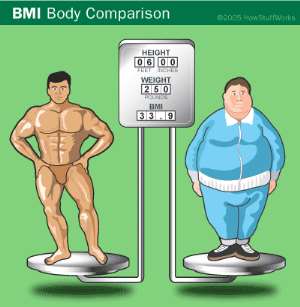
The BMI is defined as weight in kilograms divided by the square of the height in metres: weight ÷ height2 = BMI. In 1997 the WHO recommended international adoption of the definition of a healthy BMI for adult women and men as between 18.5 and 24.9. A BMI lower than 18.5 is considered underweight; a BMI of 25 or higher denotes overweight and, within that category, 30 or higher indicates obesity. Definitions of overweight and obesity are more difficult to quantify for children, whose BMI changes with age. A high BMI assumes a higher percentage of body fat, which places a person at greater risk for developing chronic diseases such as diabetes mellitus, hypertension, heart disease, and even cancer which are commonly termed as diseases of civilization.
However, for some people the BMI is not a reliable indication of health. A highly muscled individual who is very fit and healthy may have a somewhat heavy body weight because muscles pack on a lot of pounds. This person may have a high BMI that improperly puts him or her in the overweight or obese categories. Likewise, thin individuals who have a low body weight with very little muscle and a higher percentage of fat may have a normal BMI, which would be an incorrect indication of healthiness. If you were able to grasp the content in this article, we feel you are now able to judge were you are falling in the BMI. Let this be an indicator to help you evaluate whether you are overweight, obese or malnourished.
JONES. H. MUNANG'ANDU (author)
Motivational speaker, health commentator &
Health practitioner
[email protected]
Mobile; 0966565670/0979362525




 2024 elections: A vote for Mahama will turn Ghana's education system upside down...
2024 elections: A vote for Mahama will turn Ghana's education system upside down...
 Dumsor: NPP will be punished in election 2024 if gov't doesn't address current s...
Dumsor: NPP will be punished in election 2024 if gov't doesn't address current s...
 There is a clear need for the downstream petroleum audit services provided by SM...
There is a clear need for the downstream petroleum audit services provided by SM...
 Akufo-Addo directs GRA, Finance Ministry to renegotiate deal with SML
Akufo-Addo directs GRA, Finance Ministry to renegotiate deal with SML
 Kofi Bentil’s love, support for Bawumia will never represent IMANI – Franklin Cu...
Kofi Bentil’s love, support for Bawumia will never represent IMANI – Franklin Cu...
 NPP outperforms NDC in health infrastructure in Ashanti Region — LIPS report
NPP outperforms NDC in health infrastructure in Ashanti Region — LIPS report
 Critics fear Togo reforms leave little room for change in election
Critics fear Togo reforms leave little room for change in election
 Current power outages purely due to mismanagement – Minority
Current power outages purely due to mismanagement – Minority
 ECG hoists red flag to fight Ashanti Regional Minister over arrest of General Ma...
ECG hoists red flag to fight Ashanti Regional Minister over arrest of General Ma...
 Mahama’s 24hr economy will help stabilise the cedi; it’s the best sellable polic...
Mahama’s 24hr economy will help stabilise the cedi; it’s the best sellable polic...
